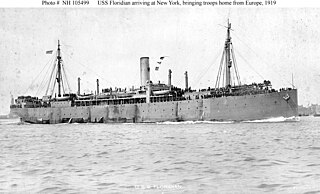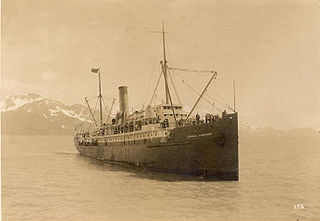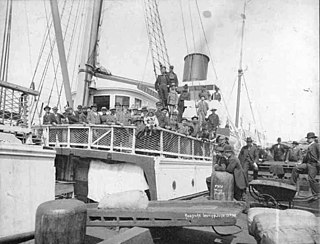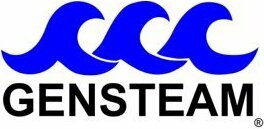Admiral is the rank, or part of the name of the ranks, of the highest naval officers.
Contents
Admiral may also refer to:
Admiral is the rank, or part of the name of the ranks, of the highest naval officers.
Admiral may also refer to:
Orion may refer to:
Olympia may refer to:
The Vikings were seafaring Scandinavians.
A monarch is the head of state of a monarchy, who holds the office for life or until abdication.

USS Stokes (AKA-68) was a Tolland-class attack cargo ship in service with the United States Navy from 1944 to 1946. She was sold into commercial service and scrapped in 1971.

The Pacific Steamship Company was a US freight and passenger shipping company that operated between 1916 and 1936. The company was formed by the merger of the Pacific Coast Steamship Company and the Pacific-Alaska Navigation Company and was a direct competitor to the Alaska Steamship Company in the Alaska-Seattle shipping business. Pacific Steamship Co. owned and operated The Admiral Line and The Admiral Oriental Line. American Mail Line worked with the Admiral Oriental Line.
Jupiter is a planet in the Solar System.

USS Floridian (ID-3875) was a United States Navy troop transport in commission in 1919.

The Moore-McCormack Lines was a series of companies operating as shipping lines, operated by the Moore-McCormack Company, Incorporated, later Moore-McCormack Lines, Incorporated, and simply Mooremack, founded in 1913 in New York City. It ceased trading on its buy-out in 1982. The founders were Albert V. Moore (1880–1953) (director/president) and Emmet J. McCormack (director/treasurer), with Mr Molloy (director/secretary).

SS President Cleveland was an American passenger ship originally ordered by the United States Maritime Commission during World War II, as one of the Admiral W. S. Benson-class Type P2-SE2-R1 transport ships, and intended to be named USS Admiral D. W. Taylor (AP-128). She became the Panamanian-flag passenger ship SS Oriental President in 1973 before being scrapped in 1974. She operated on routes in the Pacific Ocean.

The SS Admiral Sampson was a U.S.-flagged cargo and passenger steamship that served three owners between 1898 and 1914, when it was rammed by a Canadian passenger liner and sank in Puget Sound. Following its sinking off Point No Point, the Admiral Sampson has become a notable scuba diving destination for advanced recreational divers certified to use rebreathing equipment.

SS Sierra Cordoba was a Norddeutscher Lloyd passenger and cargo ship completed 1913 by AG Vulcan Stettin. The ship operated between Bremen and Buenos Aires on the line's South American service and was equipped with wireless and "submarine sounding apparatus" with accommodations for 116 first class, 74 second class and 1,270 "between decks" passengers. A description after the ship had been seized and restored in 1919 noted she was among the fastest and best equipped ships of the line with accommodations for 115 first class passengers and 1,572 third and steerage class passengers as well as a crew of 179 officers and men.

SS Roanoke (1882–1916) was a passenger and cargo ship built by John Roach & Sons in Chester, Pennsylvania. The Roanoke was built for the Old Dominion Steamship Company's service from New York to Norfolk Virginia. In 1898 the ship was sold to the North American Transportation and Trading Company to take miners, supplies and gold between Seattle and ports in Alaska. Later the Roanoke was sold to the Oregon-based North Pacific Steamship Company. In 1907, the Roanoke helped to rescue the survivors of her former running mate Columbia. On May 9, 1916, the Roanoke sank in heavy seas off the California coast near San Luis Obispo with the loss of 47 lives. There were only three survivors.

SS Luxembourg Victory was a Victory ship built for the United States during World War II. She was launched by the Oregon Shipbuilding Corporation on February 28, 1944, and was completed on April 5, 1944. The ship's US Maritime Commission designation was VC2-S-AP3, hull number 90 (V-90). She was built in 101 days under the Emergency Shipbuilding program. The Maritime Commission turned her over to a civilian contractor, the Lykes Brothers SS Company, for operation until the end of World War II hostilities. She was operated under the US Merchant Marine Act for the War Shipping Administration.
The following index is provided as an overview of and topical guide to Wikipedia's articles on recreational dive sites. The level of coverage may vary:

Recreational dive sites are specific places that recreational scuba divers go to enjoy the underwater environment or for training purposes. They include technical diving sites beyond the range generally accepted for recreational diving. In this context all diving done for recreational purposes is included. Professional diving tends to be done where the job is, and with the exception of diver training and leading groups of recreational divers, does not generally occur at specific sites chosen for their easy access, pleasant conditions or interesting features.

American Mail Line of Seattle, Washington was a commercial steamship service with routes to and from Seattle, Washington and the Far East. American Mail Line was founded in 1920, by Pacific Steamship Company also with a $500,000 investment from Dollar Shipping Company. The American Mail Line operated regular service until June 1938. American Mail Line was not profitable and ran with subsidies from Dollar, due to the cancellation of the ocean mail contracts. American Mail Line - And their affiliate Dollar Steamship Lines operated Trans-Pacific Routes, primarily from China and Japan to Canada and the United States. Some of the American Mail Line ships come for the Admiral Oriental Company when Dollar became the owner of Admiral Oriental Line. Admiral Oriental Line formed by H. F. Alexander was acquired in 1922 and renamed the American Mail Line

General Steamship Company was founded in 1920 in Houston, Texas, as a Private Company, and now goes by Gensteam since 1996. General Steamship Company has a fleet of cargo ships that operate worldwide. Gensteam has a Gensteam Operations Desk website that tracks all shipping logistics. Gensteam headquarters is now in San Francisco, California. General Steamship Company was part owner of American Pacific Steamship Company in New York state and Los Angeles during and post World War II. American Pacific Steamship Company was founded in 1942 in New York City, and was previously called Los Angeles Tanker Operators Inc. which operated T2 tanker ships. During World War II the General Steamship Company and American Pacific Steamship Company were active with charter shipping with the Maritime Commission and War Shipping Administration.

Black Diamond Steamship Company (BDSC) operated passenger and cargo liners from New York City to Rotterdam and Antwerp. It was founded by J.E. Dockendorff in 1919, and named the American Diamond Line by the United States Shipping Board. The company was profitable in the 1920s and early 1930s. Prior to the United States' entry into World War II, the nation's neutrality policy ended much of the lines trade. Dockendorff stepped down as a principal executive in 1934, selling the only one of the company's 21 ships not owned by the government: New Britain, which he had bought in 1918. During World War II the company sold most of its American Diamond Line ships and moved to charter shipping with the Maritime Commission and War Shipping Administration. During the war, the Black Diamond Steamship Company operated Victory ships and Liberty ships. These ships were operated by their own crews; the US Navy supplied United States Navy Armed Guards to man the deck guns and radio. The most common armament mounted on these merchant ships were the MK II 20mm Oerlikon autocannon and the 3"/50, 4"/50, and 5"/38 deck guns. After the war there were many surplus ships and much competition. Black Diamond Steamship Company continued to operate after the war, but finally closed in 1955.
Prudential Steamship Corporation was a shipping company founded in 1933 in New York City by Stephan Stephanidis. Prudential Steamship Corporation operated the Prudential Lines. Prudential Lines main routes was from the United States to Mediterranean ports. The Prudential Lines was never successful and was always near bankruptcy. Prudential Lines was active in supporting the World War II efforts. At its peak in the 1960s Prudential Lines owned and operated two tankers, and five cargo ships. In 1960 the Prudential Steamship Corporation was sold to Spyros Skouras and his family. In 1969 the Prudential Lines merged with Grace Lines, which continued to operate the fleet as the Prudential Grace Line.